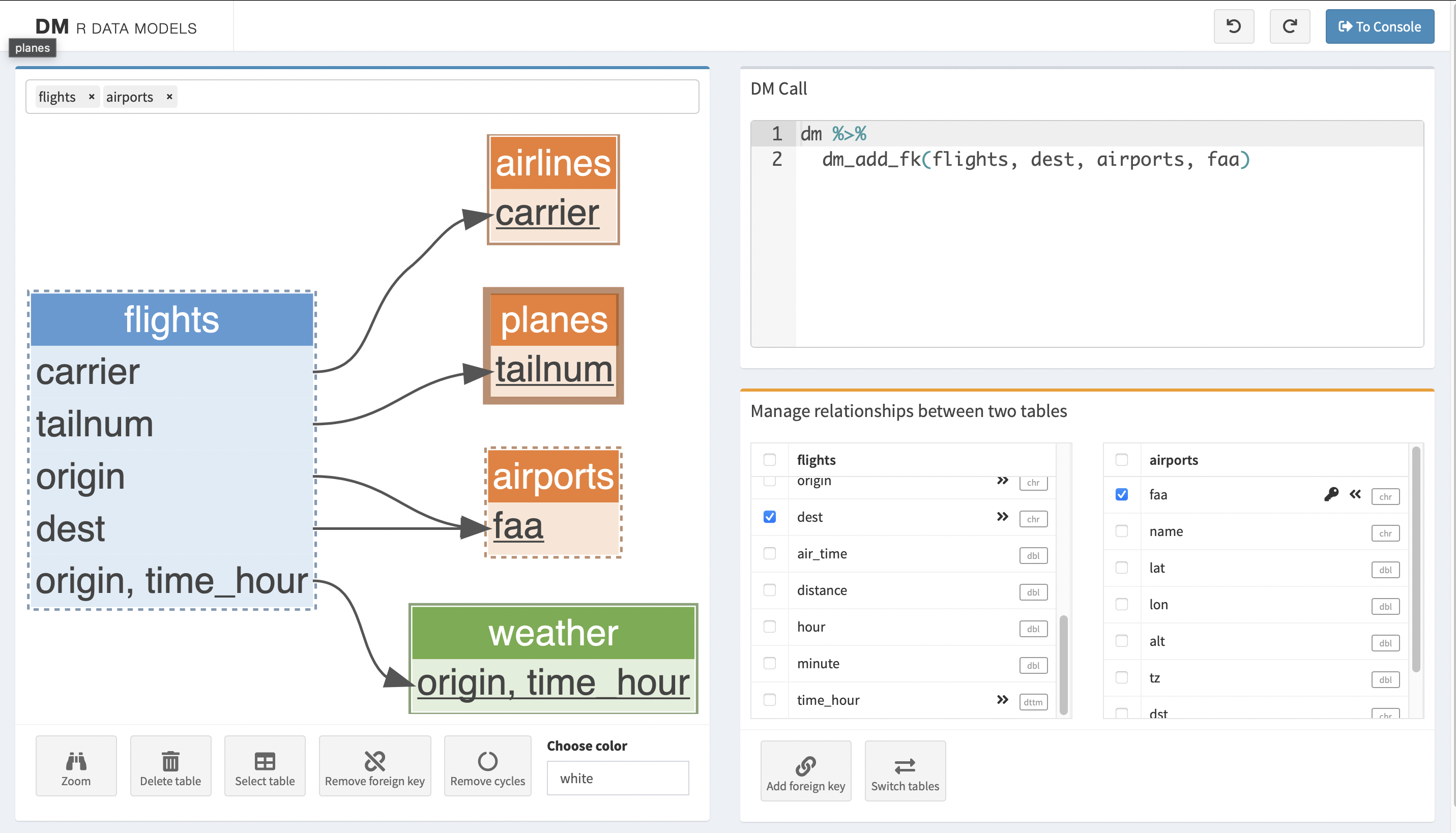If you have more than one table, use dm.
Create dm…
from database:
dm_from_con()
con <- DBI::dbConnect(...)
dm_from_con(con)
from data frames:
dm(df1, df2, ...)
dm(df1, df2, df3)Add keys: dm_add_pk(), dm_add_fk()
Automatic for MariaDB, SQL Server, Postgres, and others.
Primary keys
Identify potential primary keys:
-
dm_enum_pk_candidates(): columns, candidate, why.
Add primary keys:
dm1 |>
dm_add_pk(table, columns)Identify potential foreign keys:
-
dm_enum_fk_candidates(): columns, candidate, why.
Add foreign keys:
dm1 |>
dm_add_fk(table, column)dm objects: relational data models
The dm package provides a grammar of relational data models. It helps maintain referential integrity.
A dm behaves like a list of tables (data frames or lazy tables) capturing relationships between the tables.
Shiny app: dm_gui(dm = dm1)

Resize dm
Select tables: dm_select_tbl(dm1, ...)
dm1 |>
dm_select_tbl(-df3)Select columns: dm_select(dm1, table, ...)
Automatic update of dm meta-information and table relations.
dm1 |>
dm_select(df3, -c3, -c4)Filter rows: dm_filter(dm1, table = (pred))
Filter rows in the table where the condition is defined, but also all directly/indirectly connected tables.
dm1 |>
dm_filter(df3 = (x == "val"))
Visualize dm:
dm_draw()
Control diagram level of detail: display…
- Only keys (default):
dm_draw(view_type = "keys_only"). - All variables:
dm_draw(view_type = "all"). - Only table names:
dm_draw(view_type = "title_only").
dm |>
dm_draw(
view_type = "title_only",
rankdir = "TB"
)Control diagram scope
To visualize fewer tables first use dm_select_tbl().
Control diagram colors: dm_set_colors()
dm |>
dm_set_colors(
pink = flights,
orange = starts_with("air")
) |>
dm_draw()Transform dm into tibble
Wide tibble: Cascade joins with
dm_flatten_to_tbl()
Only direct neighbours: dm_flatten_to_tbl()
dm1 |>
dm_flatten_to_tbl(
.start = df1
)All neighbours: dm_flatten_to_tbl(.recursive = TRUE)
dm1 |>
dm_flatten_to_tbl(
.start = df1,
.recursive = TRUE
)Single tibble dm: dm_wrap_tbl()
Parent tables are packed — dm_pack_tbl().
Child tables are nested — dm_nest_tbl().
dm1 |>
dm_wrap_tbl(
root = green_df
)Retrieve one table of the dm: pull_tbl()
dm1 |>
pull_tbl(
dm1,
green_df,
keyed = TRUE
)If the dm is zoomed, retrieve zoomed table automatically.
dm1 |>
dm_zoom_to(green_df) |>
pull_tbl()Mutate, create, analyze tables
Method 1: deconstruct and reconstruct
-
dm_get_tables(keyed = TRUE):
to keep information on primary and foreign keys).
dm_tbl <- dm1 |>
dm_get_tables(keyed = TRUE)- tidyverse pipeline on the table of interest.
new_table1 <- dm_tbl$table1 |>
mutate(...)- Optional: update the dm object:
dm1 |>
dm_select_tbl(-table1) |>
dm(table1 = new_table1)Method 2: zoom
-
dm_zoom_to(): Zoom on a table.
zoomed_dm1 <- dm1 |>
dm_zoom_to(green_df)- tidyverse pipeline (
mutate(), etc.).
zoomed_dm2 <- zoomed_dm1 |>
mutate(var = thing)-
dm_update_zoomed()(replace) /dm_insert_zoomed()
dm3 <- zoomed_dm2 |>
dm_update_zoomed()Modify database source of a dm
Export dm
object to database: copy_dm_to()
Need a database connection —
DBI::dbConnect().
con <- DBI::dbConnect(...)
# Persistent tables:
persistent_dm <- copy_dm_to(
con,
dm1,
temporary = FALSE
)
DBI::dbDisconnect(con)Insert, update or remove rows in a dm
Methods:
-
dm_rows_insert(dm1, dm2): adds new rows -
dm_rows_update(dm1, dm2): changes values in rows -
dm_rows_patch(dm1, dm2): fills in missing values -
dm_rows_upsert(dm1, dm2): adds new or changes rows -
dm_rows_delete(dm1, dm2): deletes rows
dm1 |>
dm_rows_insert(dm2, in_place = FALSE)
dm1 |>
dm_rows_insert(dm2, in_place = TRUE)A dm is immutable, except with
- these functions AND
- a mutable backend (database) AND
-
in_place = TRUE.
